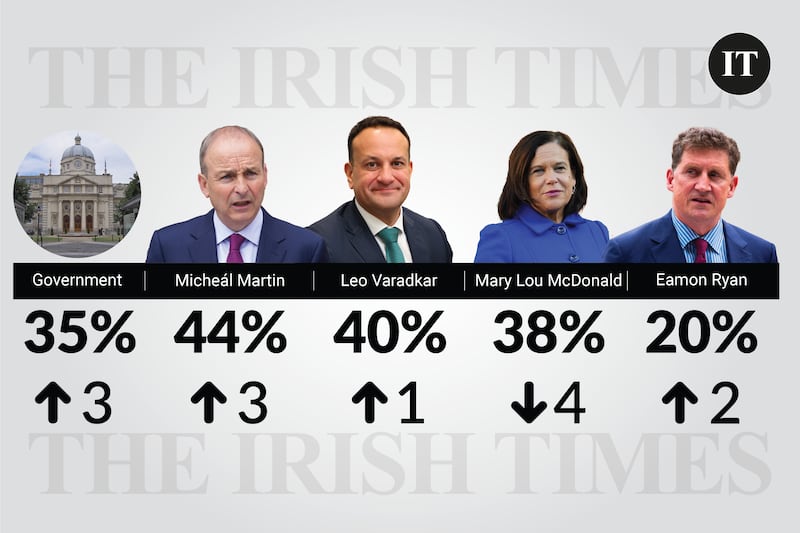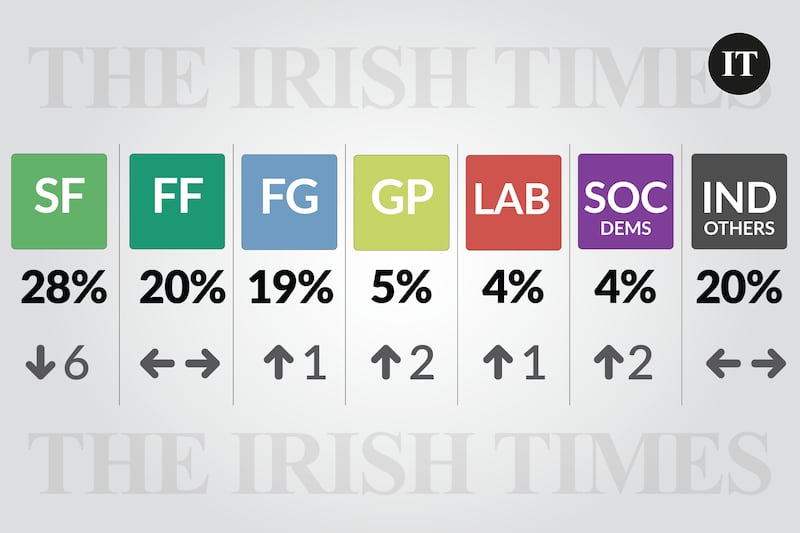It’s not hard to see the big message in today’s first Irish Times/Ipsos poll of 2024: the Sinn Féin slump.
Mary Lou McDonald’s party falls by six points to 28 per cent – the lowest it’s been since February of 2021. Only once since the 2020 election has it been lower in The Irish Times/Ipsos series. It’s the biggest fall any party has seen in a single poll since the election, and it slashes the gap between Sinn Féin and Fianna Fáil/Fine Gael to its smallest in the post-Covid period.
So, days after the party triumphantly occupied the First Minister’s office in Stormont, its fortunes in the South appear to be heading in the opposite direction. This will worry the party leadership and, if it doesn’t, it should.
It is not, perhaps, surprising that the breakthrough in the North doesn’t yield a southern political dividend for Sinn Féin; the politics of Northern Ireland plays a limited role, if any, in the politics of the South. But it is still disappointing for the party, which nurtures hopes of power in both parts of the island as a way of advancing its united Ireland agenda.
READ MORE
So what has changed since last year when the party was riding high? It seems likely the driving force behind today’s changes may be found in the party’s recent performance and its reaction to events in the Republic.
The most obvious thing is that new salience of immigration/asylum issues, and especially the accommodation arrangements for people seeking international protection/asylum here.
As we know from the recent Irish Times/Ipsos B&A Snapshot, issues related to immigration have leaped to the top of the list that people are noticing. This has not, it seems, worked to the advantage of Sinn Féin. Nor has its fierce focus on the conflict in Gaza, where it is jostling for attention with several other Opposition parties, some of whom – perhaps unconstrained by the prospect of government – are louder.
There was also party leader Mary Lou McDonald’s response to the Dublin riots in November, putting down a motion of no confidence in the Dáil in the Minister for Justice and the Garda Commissioner – when much public debate seemed more focused on the rioters and the threat they posed to law and order.
Last weekend, despite declaring no confidence in him, McDonald seemed unable to say in an RTÉ interview if she would sack Garda Commissioner Drew Harris if she became Taoiseach. McDonald’s personal rating also falls today, by four points to 38 per cent. Both Leo Varadkar and Micheál Martin now have higher approval ratings.

Sinn Féin has tried desperately to refocus on housing – the issue on which, above all, its strong polling in recent years has been built. But McDonald’s wish, as revealed in an Irish Times interview before Christmas, to see house prices fall sharply has opened a flank for the Government parties to attack. She may well be right about it, but it’s a hard sell politically, as the Sinn Féin leader is finding out.
Lurking underneath all these tactical difficulties for Sinn Féin is the more substantial strategic conundrum – how do you stand as the party of change, if you are simultaneously promising you won’t change lots of things, principally Ireland’s economic model?
And how do you keep the door open to a possible coalition with Fianna Fáil while trying to attract voters that are hell-bent on removing FF and FG from office? Perhaps the strains are beginning to tell.
There is one bright spot for Sinn Féin, though – there is no sign of any significant revival in Fianna Fáil or Fine Gael’s numbers. Fine Gael edges up by one to 19 per cent, and Fianna Fáil is steady on 20 per cent. There is no sign here of a comeback for them in these numbers. Perhaps that may temper their glee at these results; though you’d suspect not.

But it does throw the race to lead the next government wide open. If you regard Fianna Fáil and Fine Gael as essentially the same party – and social media debate (if that is not too grandiose a term) suggests that many Sinn Féin supporters do – then FF/FG now has a hefty lead on SF. Figuring out the next election (to be held within the next 13 months), and the government that follows it, just got a lot more complicated.
It is a good day for many of the smaller parties, insofar as it goes. The Greens nudge up two points to 5 per cent, bringing the combined support of the three Coalition parties to 44 per cent – well behind the 50 per cent they won at the 2020 election, but good enough to suggest that the return of the current Government, perhaps with support from some independents (which they currently enjoy anyway), is not a pipe dream.
Green seats will be under pressure everywhere, for sure; but they are not out of the game yet. The rise in satisfaction ratings for the Government and its three leaders will give further encouragement.
In advance of her national conference in Dublin the weekend after next, Social Democrats leader Holly Cairns gets a boost with her party up by two, while even Labour has something to smile about, rising by one point, while Solidarity-People Before Profit also sees its support climb by a point to 2 per cent. Aontú is steady on 1 per cent; independents are down one to 17.
It’s important to add, however, that all these changes for the smaller parties are within the margin of error, and all small parties need strong local candidates in those places where they have a chance of a seat – national polls, in other words, are not the best judge of their fortunes.
Still, they’ll take it, all the same. The prospects for the next election remain highly uncertain, and we know that the decisive moves only happen during the campaign itself. Before that, however, polls are the best measure we have. And this one seems likely to affect the political mood more than most.
- Sign up for push alerts and have the best news, analysis and comment delivered directly to your phone
- Find The Irish Times on WhatsApp and stay up to date
- Our In The News podcast is now published daily – Find the latest episode here













